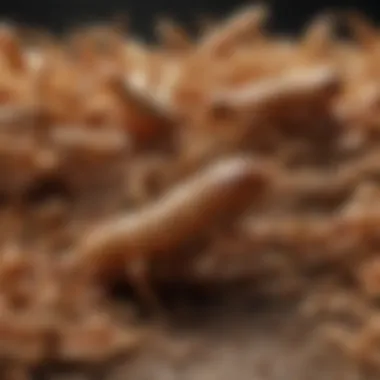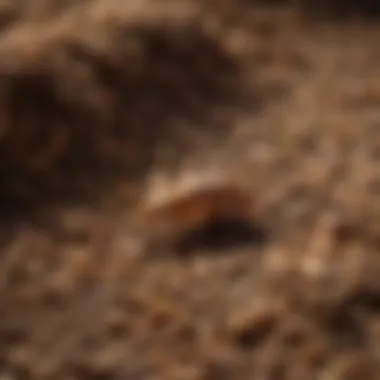Understanding Mealworm Infestation in Agriculture


Intro
Mealworm infestations represent a significant concern in agricultural practices, often leading to unforeseen economic losses and impacts on crop health. By grasping the intricacies of these infestations, stakeholders can better prepare themselves against these pesky critters. Understanding what mealworms are, how they spread, and the potential ramifications of their presence is crucial for farmers, agronomists, and even hobbyist gardeners. This article delves into various aspects of mealworm infestations, focusing on their causes, consequences, and viable solutions to manage them effectively.
Topic Overview
Definition of Key Terms
Let’s start with some basic terminology. At the core, mealworms are the larval stage of the darkling beetle, scientifically known as Tenebrio molitor. These small, yellowish-brown worms thrive in stored grains, dried fruits, and other organic matter, posing a threat particularly to agricultural environments. By understanding the lifecycle of these pests, which spans from egg to larva to pupa and finally to beetle, stakeholders can identify critical intervention points.
Relevance in Agriculture, Horticulture, and Agronomy
Mealworm infestations can occur in various agricultural settings, impacting everything from grain stores to livestock feed. The repercussions often trickle down to the end consumer, as ineffective management can lead to decreased product quality and food safety issues. Mealworms don’t just tear through crops and supplies; they can disrupt the ecosystem balance in agronomy practices, complicating efforts for sustainable farming.
The relevance of recognizing these infestations extends beyond just damage control; it's about maintaining the integrity and reliability of agricultural produce. For example, consider the thirty percent loss in stored grain due to pests each year. Understanding the causes and solutions to mealworm infestations could significantly reduce this loss and enhance overall productivity in farming.
Current Trends and Innovations
Recent Advancements in the Field
In the realm of agriculture, awareness about the ecological impact of mealworms has grown. Many innovative techniques are emerging around sustainable pest management. Recent studies have exemplified how integrating natural predators or employing biocontrol agents can effectively reduce mealworm populations without harming the environment.
Emerging Technologies and Practices
Concurrently, advancements in monitoring technology are making waves in pest management strategies. The use of artificial intelligence and machine learning to predict infestation patterns and identify vulnerabilities in storage systems is gaining traction. Drones equipped with thermal imaging can also detect temperature variations that may signal moisture problems, thus creating a conducive environment for mealworms. These innovations represent a notable shift from traditional methods, allowing for targeted interventions that arise before serious infestations occur.
Practical Applications
Step-by-Step Guides or How-Tos
To effectively manage mealworm infestations, consider the following approach:
- Inspect Regularly - Routine checks on storage areas are essential for early detection. Look for signs of wriggling worms or webbing near grain storage.
- Maintain Clean Storage - Clear out any spillage or residues that can attract mealworms. Cleanliness deters their proliferation.
- Control Temperatures - Lowering temperatures in storage areas can hinder mealworm development, as they thrive in warm environments.
- Utilize Traps - Employing pheromone traps can assist in monitoring male mealworm populations, providing actionable insights for managing infestations.
Tips and Best Practices for Implementation
- Implement Integrated Pest Management (IPM) principles, combining cultural, mechanical, and biological controls.
- Be mindful of the source – purchasing grains from reputable suppliers can minimize the risk of introducing mealworms.
- Consider natural deterrents such as diatomaceous earth, which can impede mealworms without harsh chemicals.
"Action is the foundational key to all success." - Pablo Picasso
Understanding and managing mealworm infestations is not merely a matter of safeguarding crops but also of promoting a harmonious agricultural ecosystem. By employing these strategies and remaining vigilant, farmers can dramatically mitigate the risks associated with mealworm infestations, ensuring healthier crops and a more sustainable approach to agriculture.
Prologue to Mealworm Infestation
Understanding the topic of mealworm infestation is crucial for anyone involved in agriculture, whether they are seasoned farmers or enthusiastic newcomers. Mealworms, often seen as mere pests, can impact crops and livestock significantly, thus highlighting the importance of awareness.
Importance of the Prolusion to Mealworm Infestation
Mealworm infestations can easily escalate if not recognized early. This section seeks to illuminate the reasons behind these infestations and the consequences they carry, helping stakeholders grasp the broader implications.
The agricultural community should consider several key elements:
- Recognition: Identifying the signs and conditions that lead to mealworm infestations can prevent larger issues down the road.
- Crop Management: An understanding of mealworm behavior is essential for managing crops effectively and ensuring their health.
- Livestock Welfare: For animal husbandry, mealworms can affect feed quality, impacting animal growth and health. Hence, it's vital to know how to recognize and address these challenges.
- Economic Impact: The economic implications of ignoring infestations can be staggering, affecting yield and profits in the long run.
This article aims not just to provide knowledge, but to shape practical strategies for managing mealworm populations. By learning to mitigate their effects, readers will be better equipped to protect their investments and ensure a sustainable agricultural practice.
"A stitch in time saves nine"—this old adage is particularly pertinent when it comes to mealworm infestations. Early identification and management can save farmers a great deal of trouble and resources.


In the sections that follow, we'll dive deeper into the definitions, lifecycle of mealworms, their causes, impacts, and, importantly, practical management strategies. Each aspect will contribute to a comprehensive understanding, which is essential for sustainable agricultural practices.
Defining Mealworms
Understanding mealworms is crucial in addressing infestation issues, especially in agriculture, where they can wreak havoc on crops and livestock. This section aims to provide valuable insights and clarity about what mealworms actually are, their biology, and the significance of their role in agricultural contexts. By defining mealworms accurately, farmers and agronomists can develop effective management strategies tailored to combat their negative impacts.
Species Overview
Mealworms belong to the larvae stage of the darkling beetle, scientifically named Tenebrio molitor. They are not your ordinary pests. It's important to recognize that several species can fall under the umbrella of mealworms, but T. molitor is the most common in agricultural settings. These larvae exhibit a golden-brown hue, which contributes to their familial name, providing a visual cue for their identification. Beyond just the coloration, these larvae can grow up to 2.5 centimeters long, presenting a size that, at first glance, may seem innocuous but can multiply rapidly.
- Habitat: Mealworms thrive in decaying organic matter, making grain storage facilities profoundly suitable for their growth. This makes improper grain storage techniques particularly problematic.
- Diet: An omnivorous diet primarily consisting of grains, seeds, and decaying plant matter positions them favorably in various ecosystems, yet makes them a formidable threat when they invade agricultural products.
The presence of other species within the same family could create confusion. For instance, lesser mealworms, known scientifically as Alphitobius diaperinus, also play a role in mealworm infestations. Knowing the right species not only helps in identification but also in understanding the specific control measures required for management.
Lifecycle of Mealworms
The lifecycle of a mealworm is a remarkable journey, segmented into four distinct stages: egg, larva, pupa, and adult beetle. Each phase has unique attributes and requirements, influencing how infestations may develop and evolve.
- Egg: The lifecycle kicks off when adult beetles lay tiny white eggs in crevices or among food substrates.
- Larva: From eggs hatch mealworm larvae, which can grow considerably over several molting phases. During this time, they can consume large amounts of organic matter.
- Pupa: After the larval stage, they enter a pupa phase, characterized by inactivity as they morph into the adult beetle. This is where they undergo significant biological changes.
- Adult Beetle: Finally, mature into adult darkling beetles, ready to reproduce and restart the cycle.
One fascinating aspect of mealworm biology is their ability to persist in environments that may not be ideal for other pests; they are quite resilient. This resilience, coupled with their rapid reproductive cycle, means that an infestation can go from small to significant in what seems like the blink of an eye.
"The secret to controlling mealworm populations lies greatly in understanding their lifecycle and habits. Knowing when to act is key."
For farmers, recognizing the lifecycle of mealworms not only aids in quick identification of infestations but also encourages the implementation of timely, appropriate management practices. The cycle can take a mere few months under optimal conditions, which underscores the urgency in addressing any signs of an outbreak, thereby protecting valuable crops and resources.
Causes of Mealworm Infestation
Understanding what fuels a mealworm infestation is essential for any farmer or agricultural enthusiast. It equips them with the knowledge of how these pests invade, enabling the implementation of proactive measures. Mealworms thrive under particular conditions and practices that create an environment ripe for their proliferation. Recognizing these attributes can help in drafting tailored strategies to combat potential outbreaks. In this section, we'll delve into three major causes of mealworm infestations— environmental conditions, improper storage practices, and high levels of moisture.
Environmental Conditions
Mealworms are notably adaptable; they flourish in specific environmental settings. Conditions such as temperature, humidity, and light play a crucial role in their survival and reproduction. Typically, mealworms prefer a relative humidity of around 50% to 70%. A dry environment is less conducive, yet if the humidity spikes, it creates ideal conditions for an infestation to take hold.
Furthermore, warmer temperatures also support their growth. Generally, an ideal temperature ranges from 20 to 30 degrees Celsius. Farmers should ensure that grain storage areas maintain a stable climate. Various agricultural practices, including crop rotation or fallow fields, can affect these conditions positively or negatively.
"Adjusting environmental factors is key to managing mealworm populations effectively. A proactive farmer can control these variables, preventing infestations before they escalate."
Improper Storage Practices
Storing grains, feeds, and organic materials without proper care can send alarm bells ringing among mealworm populations. Leaving food products unsealed, forgotten in a storage unit, or stacked away allows easy access for mealworms. Even tiny cracks or gaps may serve as a gateway for these pests to infiltrate.
One critical practice is to utilize airtight containers for seed and feed storage. This not only keeps mealworms at bay but also deters other pests looking for a snack. Remember, just having the right conditions is not enough; understanding that poor practices lead to vulnerabilities is paramount.
- Proper sealing and labeling of containers
- Regular inspection of storages for signs of infestation
- Keeping storage areas clean and dry
These steps can minimize risk significantly.
High Levels of Moisture
High levels of moisture create a perfect breeding ground for mealworms. Many agricultural products, including some grains, can retain moisture and subsequently become a hospitable environment for mealworms.
In addition, the infestation may take root unnoticed. Moist environments invite mealworm larvae to travel and multiply, making it a genuine concern for farmers. Areas exposed to rain, leaks in storage facilities, or damp soil can escalate the problem quickly.
Hence, moisture control is not merely important; it’s paramount. Some practical steps to manage moisture include:
- Ensuring proper ventilation in storage areas
- Using desiccants, like silica gel, in high moisture areas
- Regularly monitoring humidity levels
- Avoiding direct contact of stored materials with wet surfaces
When farmers adopt these practices, they can successfully navigate the challenges mealworms pose.


In summary, the causes of mealworm infestations intertwine with environmental conditions, improper storage practices, and moisture levels. By acknowledging these factors, agricultural stakeholders can take informed steps toward mitigating risks and sustaining their investments.
Impacts of Mealworm Infestation
Understanding the impacts of mealworm infestation is crucial for anyone involved in agriculture. The presence of these pests can lead to a cascade of negative effects, affecting not just immediate crop yields but also long-term sustainability and economic viability. Farmers and agronomists must grapple with various challenges stemming from mealworm activity, so it's paramount to recognize these implications clearly.
Effects on Crops
Mealworms are known for their insatiable appetite, particularly for grains and cereals. When they invade a field or storage area, they can wreak havoc on crops. The damage includes:
- Direct consumption of plant material, leading to reduced quality and yield.
- Contamination with feces and shed skins, which can compromise the safety and marketability of the produce.
- Increased risk of diseases, as their chewing can create openings for pathogens.
Farmers often find themselves in a tight spot. With mealworms consuming their hard-earned crops, they face potential losses. For example, a significant infestation in a wheat storage silo may not only lead to a drastic decline in grain quality but also prompt additional costs for cleaning and pest control.
Consequences for Livestock
Livestock can also bear the brunt of mealworm infestations. Feeding contaminated feed can result in a slew of health issues for animals. Some potential problems include:
- Nutritional deficiencies when feed is compromised or significantly reduced by pest activity.
- Gastrointestinal disturbances, which can manifest as upset stomachs or worse.
- Reduced productivity, as animals may be less inclined to eat if their feed is unappealing or infested.
It's a welfareconcern too. When livestock aren't healthy, it reflects not only poorly on the farm but also affects overall productivity. Farmers face a dual challenge: managing pests while ensuring their animals remain in peak health.
Economic Implications for Farmers
From an economic standpoint, the ramifications of a mealworm infestation can be extensive. The interplay of crop loss and livestock complications can hinder profitability. Some economic aspects to consider include:
- Increased operational costs associated with pest control measures and repairs.
- Potential loss of consumers due to the reduced quality of crops and feed—if one farmer faces issues, the ripple effect can harm others in the community.
- Market price drops caused by oversupply of low-quality products as infested grains flood local markets.
"Ultimately, addressing mealworm infestations isn't just about pest control. It's about safeguarding livelihoods and ensuring the future of sustainable farming practices."
Identifying Mealworm Infestation
Understanding mealworm infestation is crucial for anyone involved in agriculture. The early detection of these pests can mean the difference between a flourishing crop and a devastating loss. Identifying an infestation not only protects the yield but also informs effective management strategies. Recognizing the signs early allows farmers to mitigate damage and employs timely interventions.
Signs of Infestation
Spotting the warning signs of mealworm infestation can feel a bit like detective work. Here are some telltale indicators:
- Presence of Live Mealworms: The first and most straightforward clue. These larvae are small, often resembling tiny, wriggling yellowish or brown worms. Finding them in stored grain should set off alarm bells.
- Damage to Stored Products: Look for holes, frass, or webbing in grain storage areas. Mealworms gnaw through grains, which can result in visible damage.
- Change in Grain Texture or Odor: If your stored grains have a musty smell or seem to have a different texture, it may be a sign of thr infestation.
- Pupal Casings: These can often be seen around grain storage areas where larvae have matured into beetles. Seeing these casings indicates a breeding population nearby.
"An ounce of prevention is worth a pound of cure." – This old saying perfectly fits the context of mealworm management. Recognizing signs early can save a lot of hassle later.
Monitoring Techniques
Keeping an eye on grain storage and monitoring for mealworm activity involves several techniques:
- Regular Inspections: Schedule consistent checks of storage facilities. Look for live insects, pupal casings, and signs of damage.
- Use of Sticky Traps: Place sticky traps around storage areas. These can capture wandering beetles, giving you a sense of the population density.
- Temperature and Humidity Monitoring: Mealworms thrive in certain environmental conditions. Maintaining lower moisture levels and monitoring temperatures can help reduce the chances of infestation.
- Sampling Grain: Collect small samples of stored grain regularly. Examine them for any signs of worms or damage.
By employing these monitoring techniques, farmers can develop a proactive approach towards mealworm infestations, making it easier to catch any problems before they spiral out of control.
Management Strategies for Mealworm Infestation
Managing mealworm infestations is crucial for anyone involved in agriculture. These pests can quickly turn into a serious problem, leading to economic losses and compromised crop quality. Having an effective strategy in place means being proactive rather than reactive. When you understand the significance of the management strategies, you can protect your crops and livestock, ultimately ensuring a sustainable agricultural environment.
Preventive Measures
Preventive measures serve as the first line of defense against mealworm invasions. Implementing these strategies can mitigate the risk of infestations before they begin. Here are some effective steps to consider:


- Regular Inspection: Frequent monitoring of stored grains, vegetables, and livestock feed is crucial. Look for signs of mealworms or any droppings. Catching an issue early can save you a world of trouble.
- Maintaining Hygiene: Keep storage areas clean and dry. Debris, old grain, and spills can attract mealworms. Often, a little housekeeping goes a long way in prevention.
- Proper Storage Solutions: Use airtight containers for storing food products. Moisture can lead to pest infestations, so always ensure that food items are dry before storage.
- Temperature Control: Mealworms thrive in warm conditions. Keeping your storage areas cool and well-ventilated can make these environments less hospitable for the pests.
By taking these preventive steps, you set a strong foundation for managing mealworm populations.
Control Techniques
Sometimes despite all precautions, mealworm infestations can still happen. That’s when control techniques come into play. These methods focus on reducing the pest population effectively and responsibly.
- Mechanical Control: Traps can be designed to catch mealworms. Simple homemade traps can include a bowl of soapy water or sticky adhesive boards. Placing these near suspected infestation zones might help reduce numbers.
- Chemical Control: If the infestation is severe, chemical pesticides may be necessary, albeit with caution. Always adhere to the recommended guidelines and assess the potential impact on your environment and crops.
- Fumigation: In some cases, fumigating the storage area can tackle a large population. It’s a more aggressive method, so it’s best to consult a professional if considering this route.
Employing these control techniques can provide a significant reduction in mealworm numbers, but it’s best to combine them with preventive measures for the best results.
Biological Control Options
Biological control options offer a more environmentally friendly way to tackle mealworm infestations. This approach leverages natural predators or parasites to keep mealworm populations in check.
- Natural Predators: Introducing certain birds, reptiles, or beneficial insects can help manage mealworm numbers. They naturally hunt for these pests, adding a biological balance to the ecosystem.
- Microbial Agents: Some microbes can target mealworms without harming beneficial insects or plants. For instance, certain strains of bacteria can be toxic to mealworms but are harmless to other organisms.
- Nemathodes: These tiny roundworms can be introduced into the infested area. They penetrate mealworms and release bacteria that cause disease, thereby lowering the pest count.
Biological methods are not only sustainable but also promote biodiversity in your agricultural practices.
In managing mealworms, an integrated approach combining preventive, control, and biological methods is often the most effective.
By understanding these management strategies, farmers and agricultural enthusiasts can better equip themselves to tackle mealworm infestations effectively. A meticulous approach ensures that both crops and livestock are safeguarded, ultimately paving the way for sustainable farming practices.
Toward Sustainable Management
In addressing mealworm infestation, the conversation must steer toward sustainable management practices. These practices are crucial not just for tackling infested crops, but they also lay the groundwork for a more resilient agricultural ecosystem. Sustainable management emphasizes harmony between human activity and natural processes, which ultimately benefits both the environment and agriculture.
Integrating Mealworms into Agriculture
Integrating mealworms into agricultural practices presents an innovative avenue for sustainability. Mealworms, primarily the larvae of the darkling beetle, are not merely pests but can serve valuable roles within an agricultural framework.
- Nutritional Benefits: Mealworms are an abundant source of protein, making them an excellent choice for animal feed. By utilizing mealworms, farmers can reduce reliance on traditional feed sources that may have larger ecological footprints.
- Waste Reduction: Mealworms thrive on organic waste, such as crop leftovers and other agricultural by-products. This not only helps in managing waste but also creates a circular economy where resources are continuously recycled.
- Soil Improvement: When integrated into composting systems, mealworms can enhance soil quality by breaking down organic matter more quickly and efficiently. Their digestion process enriches compost, leading to better nutrient availability for plants.
By embracing these benefits, farmers can not only mitigate the threats posed by infestation but also enhance overall productivity.
Research and Innovations
The realm of mealworm management is being propelled forward by ongoing research and technological innovations. These advancements are essential for developing effective strategies to incorporate mealworms into sustainable practices while managing infestations.
- Developing Resistant Crops: Scientists are investigating genetic modifications to create crop varieties that can withstand mealworm damage. Such advancements hold promise for crop resilience, enabling farmers to secure yields.
- Precision Agriculture: Utilizing technology like drones and sensors, farmers can monitor mealworm populations in real-time. This precision allows for timely interventions that curb infestations without unnecessary pesticide application.
- Biotechnological Applications: Researchers are exploring the potential for using mealworms in bioconversion processes to transform waste into valuable commodities. This includes investigations into their use in waste management systems, where they can help reduce landfill impact.
Innovations like these not only tackle the immediate issue of mealworm infestation but also paint a hopeful picture for the future of sustainable agriculture.
"Sustainability in agriculture is not just a goal, but a necessity for future food security and environmental health."
Ultimately, moving toward sustainable management requires a multifaceted approach that combines understanding mealworm biology, innovative research, and practical applications in agriculture. In doing so, we create a balanced ecosystem where farmers can thrive while ensuring environmental stewardship.
Epilogue
In concluding this exploration of mealworm infestation, the significance of comprehending this topic resonates strongly within the agricultural sector. Mealworms, though small, can yield substantial consequences that ripple through farming practices, affecting both crop production and livestock health. As highlighted throughout this article, recognizing the environmental triggers, understanding the severe impacts, and implementing efficient management strategies become crucial for farmers and enthusiasts alike.
By grasping the life cycle and habits of mealworms, farmers can better prepare themselves to combat potential infestations. Knowledge empowers decisions; with insights into preventive measures, farmers stand a stronger chance against the destructive nature of these pests. The balance between accepting the presence of mealworms and not allowing them to wreak havoc is key to sustainable agriculture.
Benefits of Addressing Mealworm Infestation:
- Enhanced Crop Yields: Effective management minimizes crop damage.
- Livestock Health: Understanding impacts ensures livestock are safeguarded against potential threats.
- Economic Stability: Lowering infestation rates directly affects profit margins and costs associated with pest control.
Considering the ecological role of mealworms within the agricultural ecosystem, it is essential to approach infestation management with a holistic mindset. While they serve as decomposers in nature, their rapid reproduction can lead to significant challenges when left unchecked.
The journey toward more sustainable management practices often requires continuous education and research. Innovations in pest control, as discussed in earlier sections, offer thrilling possibilities for integrating mealworm management directly into agricultural practices.
"Knowledge is power, and in the world of agriculture, understanding pests like mealworms is an essential step towards maintaining productivity and sustainability."
Thus, as we draw this discussion to a close, it's clear that farmers and agricultural stakeholders must navigate the complexities of mealworm management with diligence and an informed approach. In doing so, they can sustain their livelihoods and contribute to a more resilient agricultural landscape.



